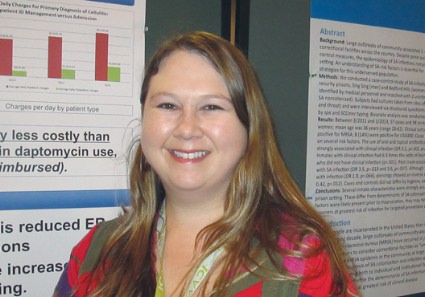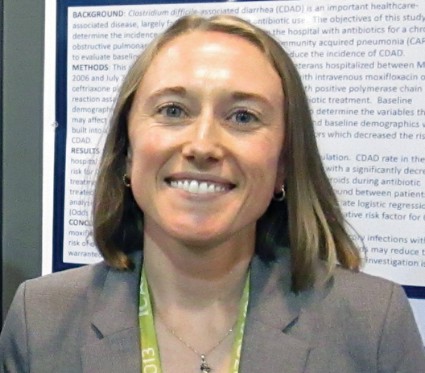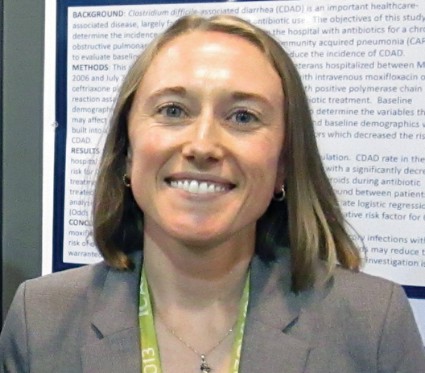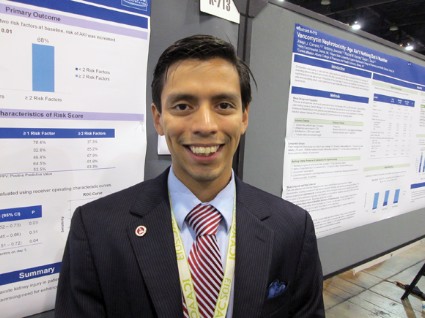User login
Interscience Conference on Antimicrobial Agents & Chemotherapy (ICAAC)
Ceftaroline fosamil cleared over 80% of bacterial skin infections
DENVER – The clinical success of ceftaroline fosamil exceeded 80% in patients with acute bacterial skin and skin structure infections, including those with underlying comorbidities and those with infections caused by methicillin-resistant Staphylococcus aureus, a multicenter, industry-funded trial demonstrated.
"At one time, MRSA infections used to be a tertiary care phenomenon," Dr. Ananthakrishnan Ramani said in an interview during a poster session at the annual Interscience Conference on Antimicrobial Agents and Chemotherapy.
"Nowadays, MRSA has become a problem in the community as well. We have seen that it’s no longer bacteremia and sepsis, but also bacterial skin and skin structure infections. Ceftaroline fosamil is the only [Food and Drug Administration]–approved cephalosporin which has activity against MRSA. That’s why this medicine is fascinating to me as an internal medicine physician and as an infectious diseases doc, because we know cephalosporins very well," he said.
Developed by Oakland, Calif.–based Cerexa Inc., ceftaroline fosamil was approved in 2010 for the treatment of acute bacterial skin and skin structure infections (ABSSSIs) and community-acquired bacterial pneumonia. The purpose of the current trial, known as CAPTURE, was to retrospectively evaluate information on the routine clinical use of intravenous ceftaroline fosamil in the United States.
At the meeting, Dr. Ramani and his associates presented data limited to 1,030 patients with ABSSSI who were treated with the agent at one of 38 centers from September 2011 through February 2013. They focused their analysis on patient demographics, disease characteristics, antibiotics, pathogens, and outcomes.
Of the 1,030 patients with ABSSSI, mean age was 58 years, mean body mass index was 34 kg/m2, and 54% were male. Nearly two-thirds (73%) were overweight or obese and 46% had diabetes mellitus. The three most common types of infection were deep/extensive cellulitis (59%), major abscesses (19%), and infected ulcers (15%); the most common infections sites were the leg/thigh (47%) and foot (24%) and infected surgical wounds (13%).
Prior to administration of ceftaroline fosamil, 77% of the patients had received antibiotics, and concurrent antibiotics, mostly clindamycin, were used in 37% of cases, said Dr. Ramani, who practices in Catskill, N.Y.
The overall clinical success rate was 85%. It was slightly lower for patients with diabetes (83%) and slightly higher for obese patients (88%). When analyzed by infection type, ceftaroline fosamil therapy achieved clinical success in 86% of major abscesses, 85% of deep/excessive cellulitis cases, 79% of infected surgical wounds, and 79% of infected ulcers, he said.
The researchers also found that clinical success was achieved in 80% of patients with diabetes and MRSA and in 83% of obese patients with MRSA. In addition, clinical success in MRSA infections with ceftaroline fosamil monotherapy was 83%, while success with concurrent therapy was 76%.
Cerexa funded the trial. Dr. Ramani has received research funding from the company.
DENVER – The clinical success of ceftaroline fosamil exceeded 80% in patients with acute bacterial skin and skin structure infections, including those with underlying comorbidities and those with infections caused by methicillin-resistant Staphylococcus aureus, a multicenter, industry-funded trial demonstrated.
"At one time, MRSA infections used to be a tertiary care phenomenon," Dr. Ananthakrishnan Ramani said in an interview during a poster session at the annual Interscience Conference on Antimicrobial Agents and Chemotherapy.
"Nowadays, MRSA has become a problem in the community as well. We have seen that it’s no longer bacteremia and sepsis, but also bacterial skin and skin structure infections. Ceftaroline fosamil is the only [Food and Drug Administration]–approved cephalosporin which has activity against MRSA. That’s why this medicine is fascinating to me as an internal medicine physician and as an infectious diseases doc, because we know cephalosporins very well," he said.
Developed by Oakland, Calif.–based Cerexa Inc., ceftaroline fosamil was approved in 2010 for the treatment of acute bacterial skin and skin structure infections (ABSSSIs) and community-acquired bacterial pneumonia. The purpose of the current trial, known as CAPTURE, was to retrospectively evaluate information on the routine clinical use of intravenous ceftaroline fosamil in the United States.
At the meeting, Dr. Ramani and his associates presented data limited to 1,030 patients with ABSSSI who were treated with the agent at one of 38 centers from September 2011 through February 2013. They focused their analysis on patient demographics, disease characteristics, antibiotics, pathogens, and outcomes.
Of the 1,030 patients with ABSSSI, mean age was 58 years, mean body mass index was 34 kg/m2, and 54% were male. Nearly two-thirds (73%) were overweight or obese and 46% had diabetes mellitus. The three most common types of infection were deep/extensive cellulitis (59%), major abscesses (19%), and infected ulcers (15%); the most common infections sites were the leg/thigh (47%) and foot (24%) and infected surgical wounds (13%).
Prior to administration of ceftaroline fosamil, 77% of the patients had received antibiotics, and concurrent antibiotics, mostly clindamycin, were used in 37% of cases, said Dr. Ramani, who practices in Catskill, N.Y.
The overall clinical success rate was 85%. It was slightly lower for patients with diabetes (83%) and slightly higher for obese patients (88%). When analyzed by infection type, ceftaroline fosamil therapy achieved clinical success in 86% of major abscesses, 85% of deep/excessive cellulitis cases, 79% of infected surgical wounds, and 79% of infected ulcers, he said.
The researchers also found that clinical success was achieved in 80% of patients with diabetes and MRSA and in 83% of obese patients with MRSA. In addition, clinical success in MRSA infections with ceftaroline fosamil monotherapy was 83%, while success with concurrent therapy was 76%.
Cerexa funded the trial. Dr. Ramani has received research funding from the company.
DENVER – The clinical success of ceftaroline fosamil exceeded 80% in patients with acute bacterial skin and skin structure infections, including those with underlying comorbidities and those with infections caused by methicillin-resistant Staphylococcus aureus, a multicenter, industry-funded trial demonstrated.
"At one time, MRSA infections used to be a tertiary care phenomenon," Dr. Ananthakrishnan Ramani said in an interview during a poster session at the annual Interscience Conference on Antimicrobial Agents and Chemotherapy.
"Nowadays, MRSA has become a problem in the community as well. We have seen that it’s no longer bacteremia and sepsis, but also bacterial skin and skin structure infections. Ceftaroline fosamil is the only [Food and Drug Administration]–approved cephalosporin which has activity against MRSA. That’s why this medicine is fascinating to me as an internal medicine physician and as an infectious diseases doc, because we know cephalosporins very well," he said.
Developed by Oakland, Calif.–based Cerexa Inc., ceftaroline fosamil was approved in 2010 for the treatment of acute bacterial skin and skin structure infections (ABSSSIs) and community-acquired bacterial pneumonia. The purpose of the current trial, known as CAPTURE, was to retrospectively evaluate information on the routine clinical use of intravenous ceftaroline fosamil in the United States.
At the meeting, Dr. Ramani and his associates presented data limited to 1,030 patients with ABSSSI who were treated with the agent at one of 38 centers from September 2011 through February 2013. They focused their analysis on patient demographics, disease characteristics, antibiotics, pathogens, and outcomes.
Of the 1,030 patients with ABSSSI, mean age was 58 years, mean body mass index was 34 kg/m2, and 54% were male. Nearly two-thirds (73%) were overweight or obese and 46% had diabetes mellitus. The three most common types of infection were deep/extensive cellulitis (59%), major abscesses (19%), and infected ulcers (15%); the most common infections sites were the leg/thigh (47%) and foot (24%) and infected surgical wounds (13%).
Prior to administration of ceftaroline fosamil, 77% of the patients had received antibiotics, and concurrent antibiotics, mostly clindamycin, were used in 37% of cases, said Dr. Ramani, who practices in Catskill, N.Y.
The overall clinical success rate was 85%. It was slightly lower for patients with diabetes (83%) and slightly higher for obese patients (88%). When analyzed by infection type, ceftaroline fosamil therapy achieved clinical success in 86% of major abscesses, 85% of deep/excessive cellulitis cases, 79% of infected surgical wounds, and 79% of infected ulcers, he said.
The researchers also found that clinical success was achieved in 80% of patients with diabetes and MRSA and in 83% of obese patients with MRSA. In addition, clinical success in MRSA infections with ceftaroline fosamil monotherapy was 83%, while success with concurrent therapy was 76%.
Cerexa funded the trial. Dr. Ramani has received research funding from the company.
AT ICAAC 2013
Major finding: In patients with acute bacterial skin and skin structure infections who were treated with ceftaroline fosamil, the overall clinical success rate was 85%. Clinical success in methicillin-resistant Staphylococcus aureus infections was 83%.
Data source: Retrospective analysis of 1,030 patients with ABSSSI who were treated from September 2011 through February of 2013.
Disclosures: Cerexa funded the trial. Dr. Ramani has received research funding from the company.
Referral approach promotes next-day ID consultation for cellulitis
DENVER – Next-day infectious diseases consultation for cellulitis reduced the number of emergency department visits and hospital admissions by 19% and 25%, respectively, a single-center study demonstrated.
This approach "is advantageous for patients if they don’t need to be admitted, and there is potential cost savings, because a lot of cost occurs during hospital admissions, especially in the first couple of days," lead study author Dr. Jennifer F. Gittzus said in an interview during a poster session at the annual Interscience Conference on Antimicrobial Agents and Chemotherapy. "Patients with cellulitis are generally very happy if they don’t have to be admitted. They prefer being treated in the outpatient setting."
Repeat emergency department (ED) visits for cellulitis are common, and inpatient admissions for cellulitis are often poorly reimbursed, noted Dr. Gittzus, of the Infectious Disease and International Travel Clinic at Concord (N.H.) Hospital. She and her colleagues hypothesized that a referral model that included next day infectious diseases (ID) consultation and ID management of outpatient intravenous (IV) antibiotics could decrease ED visits for cellulitis and perhaps also decrease admissions and/or length of stay. To find out, the researchers compared ED visits and hospital admission for cellulitis year 2010 (the year prior to this referral service being available), with those that occurred in 2011 and 2012.
Dr. Gittzus reported that between 2010 and 2012, ED visits for cellulitis fell from 948 to 748, for a reduction of 19%, while outpatient cellulitis episodes (defined as one episode potentially encompassing several days of therapy) rose from 23 to 271, an increase of more than 1,000%. Over the same time period, the number of inpatient hospital admissions for cellulitis dropped from 320 to 241, a reduction of 25%. As a consequence, daptomycin use increased at Concord Hospital from 86 days of therapy in 2010 to 571 days of therapy in 2012, "but this occurred mostly in the [ED] and outpatient settings," Dr. Gittzus emphasized.
Overall, the cost for outpatient management of cellulitis was a fraction of the cost of a hospital admission for cellulitis. For example, in 2010, the average daily inpatient charges and average daily outpatient charges were $3,818.79 and $574.42, respectively, while in 2012 those same charges stood at $5,229.96 and $1,633.40.
"We were surprised at how well this referral services was used by the emergency department," Dr. Gittzus said. "We’re actually expanding this [approach] to other diagnoses that benefit from IV antibiotics but don’t necessarily need acute hospital admission."
Dr. Gittzus said that she had no relevant conflicts of interest to disclose.
DENVER – Next-day infectious diseases consultation for cellulitis reduced the number of emergency department visits and hospital admissions by 19% and 25%, respectively, a single-center study demonstrated.
This approach "is advantageous for patients if they don’t need to be admitted, and there is potential cost savings, because a lot of cost occurs during hospital admissions, especially in the first couple of days," lead study author Dr. Jennifer F. Gittzus said in an interview during a poster session at the annual Interscience Conference on Antimicrobial Agents and Chemotherapy. "Patients with cellulitis are generally very happy if they don’t have to be admitted. They prefer being treated in the outpatient setting."
Repeat emergency department (ED) visits for cellulitis are common, and inpatient admissions for cellulitis are often poorly reimbursed, noted Dr. Gittzus, of the Infectious Disease and International Travel Clinic at Concord (N.H.) Hospital. She and her colleagues hypothesized that a referral model that included next day infectious diseases (ID) consultation and ID management of outpatient intravenous (IV) antibiotics could decrease ED visits for cellulitis and perhaps also decrease admissions and/or length of stay. To find out, the researchers compared ED visits and hospital admission for cellulitis year 2010 (the year prior to this referral service being available), with those that occurred in 2011 and 2012.
Dr. Gittzus reported that between 2010 and 2012, ED visits for cellulitis fell from 948 to 748, for a reduction of 19%, while outpatient cellulitis episodes (defined as one episode potentially encompassing several days of therapy) rose from 23 to 271, an increase of more than 1,000%. Over the same time period, the number of inpatient hospital admissions for cellulitis dropped from 320 to 241, a reduction of 25%. As a consequence, daptomycin use increased at Concord Hospital from 86 days of therapy in 2010 to 571 days of therapy in 2012, "but this occurred mostly in the [ED] and outpatient settings," Dr. Gittzus emphasized.
Overall, the cost for outpatient management of cellulitis was a fraction of the cost of a hospital admission for cellulitis. For example, in 2010, the average daily inpatient charges and average daily outpatient charges were $3,818.79 and $574.42, respectively, while in 2012 those same charges stood at $5,229.96 and $1,633.40.
"We were surprised at how well this referral services was used by the emergency department," Dr. Gittzus said. "We’re actually expanding this [approach] to other diagnoses that benefit from IV antibiotics but don’t necessarily need acute hospital admission."
Dr. Gittzus said that she had no relevant conflicts of interest to disclose.
DENVER – Next-day infectious diseases consultation for cellulitis reduced the number of emergency department visits and hospital admissions by 19% and 25%, respectively, a single-center study demonstrated.
This approach "is advantageous for patients if they don’t need to be admitted, and there is potential cost savings, because a lot of cost occurs during hospital admissions, especially in the first couple of days," lead study author Dr. Jennifer F. Gittzus said in an interview during a poster session at the annual Interscience Conference on Antimicrobial Agents and Chemotherapy. "Patients with cellulitis are generally very happy if they don’t have to be admitted. They prefer being treated in the outpatient setting."
Repeat emergency department (ED) visits for cellulitis are common, and inpatient admissions for cellulitis are often poorly reimbursed, noted Dr. Gittzus, of the Infectious Disease and International Travel Clinic at Concord (N.H.) Hospital. She and her colleagues hypothesized that a referral model that included next day infectious diseases (ID) consultation and ID management of outpatient intravenous (IV) antibiotics could decrease ED visits for cellulitis and perhaps also decrease admissions and/or length of stay. To find out, the researchers compared ED visits and hospital admission for cellulitis year 2010 (the year prior to this referral service being available), with those that occurred in 2011 and 2012.
Dr. Gittzus reported that between 2010 and 2012, ED visits for cellulitis fell from 948 to 748, for a reduction of 19%, while outpatient cellulitis episodes (defined as one episode potentially encompassing several days of therapy) rose from 23 to 271, an increase of more than 1,000%. Over the same time period, the number of inpatient hospital admissions for cellulitis dropped from 320 to 241, a reduction of 25%. As a consequence, daptomycin use increased at Concord Hospital from 86 days of therapy in 2010 to 571 days of therapy in 2012, "but this occurred mostly in the [ED] and outpatient settings," Dr. Gittzus emphasized.
Overall, the cost for outpatient management of cellulitis was a fraction of the cost of a hospital admission for cellulitis. For example, in 2010, the average daily inpatient charges and average daily outpatient charges were $3,818.79 and $574.42, respectively, while in 2012 those same charges stood at $5,229.96 and $1,633.40.
"We were surprised at how well this referral services was used by the emergency department," Dr. Gittzus said. "We’re actually expanding this [approach] to other diagnoses that benefit from IV antibiotics but don’t necessarily need acute hospital admission."
Dr. Gittzus said that she had no relevant conflicts of interest to disclose.
AT ICAAC 2013
Major finding: After implementation of a referral model that supported next-day ID consultation for cellulitis and ID management of IV antibiotics, repeat ED visits for cellulitis fell from 948 to 748, for a reduction of 19%, while the number of inpatient hospital admissions for cellulitis dropped from 320 to 241, a reduction of 25%.
Data source: Comparison of the number of ED visits and hospital admission for cellulitis in 2010 (the year prior to this referral service being available) with 2011 and 2012.
Disclosures: Dr. Gittzus said that she had no relevant financial conflicts of interest to disclose.
Steroids May Cut Antibiotics-related C difficile Risk
DENVER – Use of systemic corticosteroids during antibiotic treatment for respiratory infections may reduce the incidence of Clostridium difficile–associated diarrhea, a single-center study demonstrated.
"Using steroids may not predispose people to having C diff, as previously thought," Amy Wojciechowski, Pharm.D., said in an interview during a poster session at the annual Interscience Conference on Antimicrobial Agents and Chemotherapy. "Don’t be afraid to use steroids when you’re treating with antibiotics. You’re not going to increase your risk of C. diff. You may even be decreasing it."
Dr. Wojciechowski, along with Kari Mergenhagen, Pharm.D., and their associates at the VA Western New York Healthcare System, Buffalo, set out to determine the incidence of Clostridium difficile–associated diarrhea (CDAD) in patients treated in the hospital with antibiotics for a chronic obstructive pulmonary disease (COPD) exacerbation or community-acquired pneumonia (CAP). The investigators evaluated baseline characteristics and risk factors that affect the incidence of CDAD.
The study population comprised 532 veterans who were hospitalized between March 2006 and July 2012 and were treated with moxifloxacin or with ceftriaxone plus azithromycin. CDAD was defined as diarrhea with positive PCR assay or toxin assay for C difficile within 30 days of antibiotic treatment.
The mean age of the veterans was 76 years, and 99% were male. The researchers found that CDAD occurred in 11 patients in the study population, for an incidence rate of 2.07%.
Variables associated with a significantly decreased risk of CDAD were diagnosis of COPD (P = .01) and use of corticosteroids during antibiotics treatment (P = .0035). There was no difference in the incidence of CDAD between patients treated with moxifloxacin and those treated with ceftriaxone plus azithromycin.
After the researchers controlled for COPD, the use of corticosteroids remained linked to a decreased risk of developing CDAD (odds ratio, 0.12).
The researchers hypothesized that steroids "may attenuate the host immune response typically seen in response to C difficile toxins, thus preventing inflammation and cytokine release associated with the symptoms of CDAD." They added that more research is needed to determine whether the findings are the same in other patient populations.
The authors acknowledged as limitations of the study its retrospective design and the fact that the majority of patients where white men.
Dr. Wojciechowski, an infectious diseases pharmacy resident, and Dr. Mergenhagen, a clinical infectious diseases pharmacist, said that they had no relevant conflicts of interest to disclose.
Dr. Marcos I. Restrepo, FCCP, comments: Be careful about jumping to many conclusions regarding the beneficial effects of corticosteroids preventing Clostridium difficile-associated diarrhea. These associations derived from retrospective studies should be assessed in randomized controlled trials before specific recommendations are translated into clinical practice.
Dr. Marco Restrepo, FCCP is with the University of Texas Health Science Center,
San Antonio, Tex.
Dr. Marcos I. Restrepo, FCCP, comments: Be careful about jumping to many conclusions regarding the beneficial effects of corticosteroids preventing Clostridium difficile-associated diarrhea. These associations derived from retrospective studies should be assessed in randomized controlled trials before specific recommendations are translated into clinical practice.
Dr. Marco Restrepo, FCCP is with the University of Texas Health Science Center,
San Antonio, Tex.
Dr. Marcos I. Restrepo, FCCP, comments: Be careful about jumping to many conclusions regarding the beneficial effects of corticosteroids preventing Clostridium difficile-associated diarrhea. These associations derived from retrospective studies should be assessed in randomized controlled trials before specific recommendations are translated into clinical practice.
Dr. Marco Restrepo, FCCP is with the University of Texas Health Science Center,
San Antonio, Tex.
DENVER – Use of systemic corticosteroids during antibiotic treatment for respiratory infections may reduce the incidence of Clostridium difficile–associated diarrhea, a single-center study demonstrated.
"Using steroids may not predispose people to having C diff, as previously thought," Amy Wojciechowski, Pharm.D., said in an interview during a poster session at the annual Interscience Conference on Antimicrobial Agents and Chemotherapy. "Don’t be afraid to use steroids when you’re treating with antibiotics. You’re not going to increase your risk of C. diff. You may even be decreasing it."
Dr. Wojciechowski, along with Kari Mergenhagen, Pharm.D., and their associates at the VA Western New York Healthcare System, Buffalo, set out to determine the incidence of Clostridium difficile–associated diarrhea (CDAD) in patients treated in the hospital with antibiotics for a chronic obstructive pulmonary disease (COPD) exacerbation or community-acquired pneumonia (CAP). The investigators evaluated baseline characteristics and risk factors that affect the incidence of CDAD.
The study population comprised 532 veterans who were hospitalized between March 2006 and July 2012 and were treated with moxifloxacin or with ceftriaxone plus azithromycin. CDAD was defined as diarrhea with positive PCR assay or toxin assay for C difficile within 30 days of antibiotic treatment.
The mean age of the veterans was 76 years, and 99% were male. The researchers found that CDAD occurred in 11 patients in the study population, for an incidence rate of 2.07%.
Variables associated with a significantly decreased risk of CDAD were diagnosis of COPD (P = .01) and use of corticosteroids during antibiotics treatment (P = .0035). There was no difference in the incidence of CDAD between patients treated with moxifloxacin and those treated with ceftriaxone plus azithromycin.
After the researchers controlled for COPD, the use of corticosteroids remained linked to a decreased risk of developing CDAD (odds ratio, 0.12).
The researchers hypothesized that steroids "may attenuate the host immune response typically seen in response to C difficile toxins, thus preventing inflammation and cytokine release associated with the symptoms of CDAD." They added that more research is needed to determine whether the findings are the same in other patient populations.
The authors acknowledged as limitations of the study its retrospective design and the fact that the majority of patients where white men.
Dr. Wojciechowski, an infectious diseases pharmacy resident, and Dr. Mergenhagen, a clinical infectious diseases pharmacist, said that they had no relevant conflicts of interest to disclose.
DENVER – Use of systemic corticosteroids during antibiotic treatment for respiratory infections may reduce the incidence of Clostridium difficile–associated diarrhea, a single-center study demonstrated.
"Using steroids may not predispose people to having C diff, as previously thought," Amy Wojciechowski, Pharm.D., said in an interview during a poster session at the annual Interscience Conference on Antimicrobial Agents and Chemotherapy. "Don’t be afraid to use steroids when you’re treating with antibiotics. You’re not going to increase your risk of C. diff. You may even be decreasing it."
Dr. Wojciechowski, along with Kari Mergenhagen, Pharm.D., and their associates at the VA Western New York Healthcare System, Buffalo, set out to determine the incidence of Clostridium difficile–associated diarrhea (CDAD) in patients treated in the hospital with antibiotics for a chronic obstructive pulmonary disease (COPD) exacerbation or community-acquired pneumonia (CAP). The investigators evaluated baseline characteristics and risk factors that affect the incidence of CDAD.
The study population comprised 532 veterans who were hospitalized between March 2006 and July 2012 and were treated with moxifloxacin or with ceftriaxone plus azithromycin. CDAD was defined as diarrhea with positive PCR assay or toxin assay for C difficile within 30 days of antibiotic treatment.
The mean age of the veterans was 76 years, and 99% were male. The researchers found that CDAD occurred in 11 patients in the study population, for an incidence rate of 2.07%.
Variables associated with a significantly decreased risk of CDAD were diagnosis of COPD (P = .01) and use of corticosteroids during antibiotics treatment (P = .0035). There was no difference in the incidence of CDAD between patients treated with moxifloxacin and those treated with ceftriaxone plus azithromycin.
After the researchers controlled for COPD, the use of corticosteroids remained linked to a decreased risk of developing CDAD (odds ratio, 0.12).
The researchers hypothesized that steroids "may attenuate the host immune response typically seen in response to C difficile toxins, thus preventing inflammation and cytokine release associated with the symptoms of CDAD." They added that more research is needed to determine whether the findings are the same in other patient populations.
The authors acknowledged as limitations of the study its retrospective design and the fact that the majority of patients where white men.
Dr. Wojciechowski, an infectious diseases pharmacy resident, and Dr. Mergenhagen, a clinical infectious diseases pharmacist, said that they had no relevant conflicts of interest to disclose.
AT ICAAC 2013
Steroids may cut antibiotics-related C. difficile risk
DENVER – Use of systemic corticosteroids during antibiotic treatment for respiratory infections may reduce the incidence of Clostridium difficile–associated diarrhea, a single-center study demonstrated.
"Using steroids may not predispose people to having C. diff., as previously thought," Amy Wojciechowski, Pharm.D., said in an interview during a poster session at the annual Interscience Conference on Antimicrobial Agents and Chemotherapy. "Don’t be afraid to use steroids when you’re treating with antibiotics. You’re not going to increase your risk of C. diff. You may even be decreasing it."
Dr. Wojciechowski, along with Kari Mergenhagen, Pharm.D., and their associates at the VA Western New York Healthcare System, Buffalo, set out to determine the incidence of Clostridium difficile–associated diarrhea (CDAD) in patients treated in the hospital with antibiotics for a chronic obstructive pulmonary disease (COPD) exacerbation or community-acquired pneumonia (CAP). The investigators evaluated baseline characteristics and risk factors that affect the incidence of CDAD.
The study population comprised 532 veterans who were hospitalized between March 2006 and July 2012 and were treated with moxifloxacin or with ceftriaxone plus azithromycin. CDAD was defined as diarrhea with positive PCR assay or toxin assay for C. difficile within 30 days of antibiotic treatment.
The mean age of the veterans was 76 years, and 99% were male. The researchers found that CDAD occurred in 11 patients in the study population, for an incidence rate of 2.07%.
Variables associated with a significantly decreased risk of CDAD were diagnosis of COPD (P = .01) and use of corticosteroids during antibiotics treatment (P = .0035). There was no difference in the incidence of CDAD between patients treated with moxifloxacin and those treated with ceftriaxone plus azithromycin.
After the researchers controlled for COPD, the use of corticosteroids remained linked to a decreased risk of developing CDAD (odds ratio, 0.12).
The researchers hypothesized that steroids "may attenuate the host immune response typically seen in response to C. difficile toxins, thus preventing inflammation and cytokine release associated with the symptoms of CDAD." They added that more research is needed to determine whether the findings are the same in other patient populations.
The authors acknowledged as limitations of the study its retrospective design and the fact that the majority of patients where white men.
Dr. Wojciechowski, an infectious diseases pharmacy resident, and Dr. Mergenhagen, a clinical infectious diseases pharmacist, said that they had no relevant conflicts of interest to disclose.
Dr. Marcos I. Restrepo, FCCP, comments: Be careful about jumping to many conclusions regarding the beneficial effects of corticosteroids preventing Clostridium difficile-associated diarrhea. These associations derived from retrospective studies should be assessed in randomized controlled trials before specific recommendations are translated into clinical practice.
Dr. Marco Restrepo, FCCP is with the University of Texas Health Science Center,
San Antonio, Tex.
Dr. Marcos I. Restrepo, FCCP, comments: Be careful about jumping to many conclusions regarding the beneficial effects of corticosteroids preventing Clostridium difficile-associated diarrhea. These associations derived from retrospective studies should be assessed in randomized controlled trials before specific recommendations are translated into clinical practice.
Dr. Marco Restrepo, FCCP is with the University of Texas Health Science Center,
San Antonio, Tex.
Dr. Marcos I. Restrepo, FCCP, comments: Be careful about jumping to many conclusions regarding the beneficial effects of corticosteroids preventing Clostridium difficile-associated diarrhea. These associations derived from retrospective studies should be assessed in randomized controlled trials before specific recommendations are translated into clinical practice.
Dr. Marco Restrepo, FCCP is with the University of Texas Health Science Center,
San Antonio, Tex.
DENVER – Use of systemic corticosteroids during antibiotic treatment for respiratory infections may reduce the incidence of Clostridium difficile–associated diarrhea, a single-center study demonstrated.
"Using steroids may not predispose people to having C. diff., as previously thought," Amy Wojciechowski, Pharm.D., said in an interview during a poster session at the annual Interscience Conference on Antimicrobial Agents and Chemotherapy. "Don’t be afraid to use steroids when you’re treating with antibiotics. You’re not going to increase your risk of C. diff. You may even be decreasing it."
Dr. Wojciechowski, along with Kari Mergenhagen, Pharm.D., and their associates at the VA Western New York Healthcare System, Buffalo, set out to determine the incidence of Clostridium difficile–associated diarrhea (CDAD) in patients treated in the hospital with antibiotics for a chronic obstructive pulmonary disease (COPD) exacerbation or community-acquired pneumonia (CAP). The investigators evaluated baseline characteristics and risk factors that affect the incidence of CDAD.
The study population comprised 532 veterans who were hospitalized between March 2006 and July 2012 and were treated with moxifloxacin or with ceftriaxone plus azithromycin. CDAD was defined as diarrhea with positive PCR assay or toxin assay for C. difficile within 30 days of antibiotic treatment.
The mean age of the veterans was 76 years, and 99% were male. The researchers found that CDAD occurred in 11 patients in the study population, for an incidence rate of 2.07%.
Variables associated with a significantly decreased risk of CDAD were diagnosis of COPD (P = .01) and use of corticosteroids during antibiotics treatment (P = .0035). There was no difference in the incidence of CDAD between patients treated with moxifloxacin and those treated with ceftriaxone plus azithromycin.
After the researchers controlled for COPD, the use of corticosteroids remained linked to a decreased risk of developing CDAD (odds ratio, 0.12).
The researchers hypothesized that steroids "may attenuate the host immune response typically seen in response to C. difficile toxins, thus preventing inflammation and cytokine release associated with the symptoms of CDAD." They added that more research is needed to determine whether the findings are the same in other patient populations.
The authors acknowledged as limitations of the study its retrospective design and the fact that the majority of patients where white men.
Dr. Wojciechowski, an infectious diseases pharmacy resident, and Dr. Mergenhagen, a clinical infectious diseases pharmacist, said that they had no relevant conflicts of interest to disclose.
DENVER – Use of systemic corticosteroids during antibiotic treatment for respiratory infections may reduce the incidence of Clostridium difficile–associated diarrhea, a single-center study demonstrated.
"Using steroids may not predispose people to having C. diff., as previously thought," Amy Wojciechowski, Pharm.D., said in an interview during a poster session at the annual Interscience Conference on Antimicrobial Agents and Chemotherapy. "Don’t be afraid to use steroids when you’re treating with antibiotics. You’re not going to increase your risk of C. diff. You may even be decreasing it."
Dr. Wojciechowski, along with Kari Mergenhagen, Pharm.D., and their associates at the VA Western New York Healthcare System, Buffalo, set out to determine the incidence of Clostridium difficile–associated diarrhea (CDAD) in patients treated in the hospital with antibiotics for a chronic obstructive pulmonary disease (COPD) exacerbation or community-acquired pneumonia (CAP). The investigators evaluated baseline characteristics and risk factors that affect the incidence of CDAD.
The study population comprised 532 veterans who were hospitalized between March 2006 and July 2012 and were treated with moxifloxacin or with ceftriaxone plus azithromycin. CDAD was defined as diarrhea with positive PCR assay or toxin assay for C. difficile within 30 days of antibiotic treatment.
The mean age of the veterans was 76 years, and 99% were male. The researchers found that CDAD occurred in 11 patients in the study population, for an incidence rate of 2.07%.
Variables associated with a significantly decreased risk of CDAD were diagnosis of COPD (P = .01) and use of corticosteroids during antibiotics treatment (P = .0035). There was no difference in the incidence of CDAD between patients treated with moxifloxacin and those treated with ceftriaxone plus azithromycin.
After the researchers controlled for COPD, the use of corticosteroids remained linked to a decreased risk of developing CDAD (odds ratio, 0.12).
The researchers hypothesized that steroids "may attenuate the host immune response typically seen in response to C. difficile toxins, thus preventing inflammation and cytokine release associated with the symptoms of CDAD." They added that more research is needed to determine whether the findings are the same in other patient populations.
The authors acknowledged as limitations of the study its retrospective design and the fact that the majority of patients where white men.
Dr. Wojciechowski, an infectious diseases pharmacy resident, and Dr. Mergenhagen, a clinical infectious diseases pharmacist, said that they had no relevant conflicts of interest to disclose.
AT ICAAC 2013
Major finding: Use of corticosteroids during antibiotics treatment was associated with a significantly lower risk of Clostridium difficile–associated diarrhea among patients hospitalized for COPD exacerbations or CAP.
Data source: A study of 532 veterans hospitalized for respiratory infections between March 2006 and July 2012 who were treated with moxifloxacin or ceftriaxone plus azithromycin.
Disclosures: The researchers had no relevant financial conflicts of interest to disclose.
Protocol boosts antimicrobial dosing practices during CRRT
DENVER – Before a new protocol was implemented, antimicrobial dosing in patients receiving continuous renal replacement therapy varied and was adherent to evidence-based recommendations in about one-quarter of antimicrobial orders, results from a single-center study showed.
"For any kind of renal replacement therapy, there is always an uncertainty as to how much residual antibiotic is being removed, how much residual renal function the patient has, and how much of the antibiotic is actually staying within the patient for them to achieve therapeutic levels of the drug to combat their infection," Jamie Wagner, Pharm.D., said in an interview during a poster session at the annual Interscience Conference on Antimicrobial Agents and Chemotherapy.
"With renal replacement therapy, everything is dependent on the filter, the flow rate, and how much residual renal function the patient has. We set out to try to determine how well the interdisciplinary teams were adhering with dosing recommendations, defined as use of evidence-based dose for each CRRT [continuous renal replacement therapy] modality employed for the entire duration of antibiotics used during CRRT."
Dr. Wagner, an infectious diseases pharmacy fellow at the 802-bed Henry Ford Hospital, Detroit, and her associates evaluated 246 antimicrobial orders placed for 43 patients from November 2008 to May 2012. Patients were included in the analysis if they had an order placed for a beta-lactam, vancomycin, tobramycin, gentamicin, or daptomycin; if they received the drug in the ICU; and if they were on CRRT at the time the drug was administered. Patients receiving intermittent hemodialysis or peritoneal dialysis were excluded from the study.
Using medical records, the researchers evaluated demographics, CRRT modality, dates of changes in CRRT, and antibiotic dosing information. Each antibiotic order was evaluated for adherence to evidence-based dosing recommendation, which was the primary outcome of interest.
In August 2011, the Henry Ford Health System implemented an institutional guideline for antibiotic dosing in CRRT, which contained a summary of evidence-based dosing recommendations for the most common antimicrobial agents used in the ICU.
Of the 43 patients, 14 met study inclusion criteria before implementation of the guideline (group A), while the remaining 29 met inclusion criteria after implementation of the guideline (group B). The mean ages of patients in both groups were similar (55 years in group A vs. 59 years in group B), as were other variables.
Dr. Wagner reported that no differences were observed in antibiotic use between pre- and postguideline antibiotic orders. The three most commonly prescribed agents were vancomycin (32%), cefepime (21%), and aminoglycosides (15%). Following implementation of the guideline, overall adherence with evidence-based dosing recommendations improved from 24% to 49% between groups A and B, a difference which reached significance (P less than .001).
Four CRRT modalities changed significantly between groups A and B: continuous venovenous hemofiltration (CVVH) for 8-12 hours (24% vs. 0%, respectively); sustained, low-efficiency, daily diafiltration (SLEDD) for 8-12 hours with an F8 filter (29% vs. 6%); SLEDD for 8-12 hours with an F250 filter (14% vs. 1%); and SLEDD for 24 hours (11% vs. 75%).
Changes between modalities occurred in 13% of all orders assessed. Variables found to be associated with nonadherent orders were change of CRRT mode that resulted in a new recommended dose (7%), SLEDD for 8-12 hours (15%), and the use of any aminoglycoside (15%).
"Communication is key between all patient care providers on a daily basis," Dr. Wagner concluded. "At Henry Ford Hospital, providers must submit a new order for CRRT every single day for patients requiring antibiotic dosing. There needs to be communication about this between all providers involved in that patient’s care."
She acknowledged certain limitations of the study, including increased use of 24-hour SLEDD during the postguideline period, strict definition for adherence to the guideline, and the inability to systematically evaluate clinical response or residual function.
"Understanding factors associated with nonadherent orders can provide a starting point for clinicians to improve the antimicrobial use process in CRRT," she said.
Dr. Wagner said that she had no relevant conflicts of interest to disclose.
DENVER – Before a new protocol was implemented, antimicrobial dosing in patients receiving continuous renal replacement therapy varied and was adherent to evidence-based recommendations in about one-quarter of antimicrobial orders, results from a single-center study showed.
"For any kind of renal replacement therapy, there is always an uncertainty as to how much residual antibiotic is being removed, how much residual renal function the patient has, and how much of the antibiotic is actually staying within the patient for them to achieve therapeutic levels of the drug to combat their infection," Jamie Wagner, Pharm.D., said in an interview during a poster session at the annual Interscience Conference on Antimicrobial Agents and Chemotherapy.
"With renal replacement therapy, everything is dependent on the filter, the flow rate, and how much residual renal function the patient has. We set out to try to determine how well the interdisciplinary teams were adhering with dosing recommendations, defined as use of evidence-based dose for each CRRT [continuous renal replacement therapy] modality employed for the entire duration of antibiotics used during CRRT."
Dr. Wagner, an infectious diseases pharmacy fellow at the 802-bed Henry Ford Hospital, Detroit, and her associates evaluated 246 antimicrobial orders placed for 43 patients from November 2008 to May 2012. Patients were included in the analysis if they had an order placed for a beta-lactam, vancomycin, tobramycin, gentamicin, or daptomycin; if they received the drug in the ICU; and if they were on CRRT at the time the drug was administered. Patients receiving intermittent hemodialysis or peritoneal dialysis were excluded from the study.
Using medical records, the researchers evaluated demographics, CRRT modality, dates of changes in CRRT, and antibiotic dosing information. Each antibiotic order was evaluated for adherence to evidence-based dosing recommendation, which was the primary outcome of interest.
In August 2011, the Henry Ford Health System implemented an institutional guideline for antibiotic dosing in CRRT, which contained a summary of evidence-based dosing recommendations for the most common antimicrobial agents used in the ICU.
Of the 43 patients, 14 met study inclusion criteria before implementation of the guideline (group A), while the remaining 29 met inclusion criteria after implementation of the guideline (group B). The mean ages of patients in both groups were similar (55 years in group A vs. 59 years in group B), as were other variables.
Dr. Wagner reported that no differences were observed in antibiotic use between pre- and postguideline antibiotic orders. The three most commonly prescribed agents were vancomycin (32%), cefepime (21%), and aminoglycosides (15%). Following implementation of the guideline, overall adherence with evidence-based dosing recommendations improved from 24% to 49% between groups A and B, a difference which reached significance (P less than .001).
Four CRRT modalities changed significantly between groups A and B: continuous venovenous hemofiltration (CVVH) for 8-12 hours (24% vs. 0%, respectively); sustained, low-efficiency, daily diafiltration (SLEDD) for 8-12 hours with an F8 filter (29% vs. 6%); SLEDD for 8-12 hours with an F250 filter (14% vs. 1%); and SLEDD for 24 hours (11% vs. 75%).
Changes between modalities occurred in 13% of all orders assessed. Variables found to be associated with nonadherent orders were change of CRRT mode that resulted in a new recommended dose (7%), SLEDD for 8-12 hours (15%), and the use of any aminoglycoside (15%).
"Communication is key between all patient care providers on a daily basis," Dr. Wagner concluded. "At Henry Ford Hospital, providers must submit a new order for CRRT every single day for patients requiring antibiotic dosing. There needs to be communication about this between all providers involved in that patient’s care."
She acknowledged certain limitations of the study, including increased use of 24-hour SLEDD during the postguideline period, strict definition for adherence to the guideline, and the inability to systematically evaluate clinical response or residual function.
"Understanding factors associated with nonadherent orders can provide a starting point for clinicians to improve the antimicrobial use process in CRRT," she said.
Dr. Wagner said that she had no relevant conflicts of interest to disclose.
DENVER – Before a new protocol was implemented, antimicrobial dosing in patients receiving continuous renal replacement therapy varied and was adherent to evidence-based recommendations in about one-quarter of antimicrobial orders, results from a single-center study showed.
"For any kind of renal replacement therapy, there is always an uncertainty as to how much residual antibiotic is being removed, how much residual renal function the patient has, and how much of the antibiotic is actually staying within the patient for them to achieve therapeutic levels of the drug to combat their infection," Jamie Wagner, Pharm.D., said in an interview during a poster session at the annual Interscience Conference on Antimicrobial Agents and Chemotherapy.
"With renal replacement therapy, everything is dependent on the filter, the flow rate, and how much residual renal function the patient has. We set out to try to determine how well the interdisciplinary teams were adhering with dosing recommendations, defined as use of evidence-based dose for each CRRT [continuous renal replacement therapy] modality employed for the entire duration of antibiotics used during CRRT."
Dr. Wagner, an infectious diseases pharmacy fellow at the 802-bed Henry Ford Hospital, Detroit, and her associates evaluated 246 antimicrobial orders placed for 43 patients from November 2008 to May 2012. Patients were included in the analysis if they had an order placed for a beta-lactam, vancomycin, tobramycin, gentamicin, or daptomycin; if they received the drug in the ICU; and if they were on CRRT at the time the drug was administered. Patients receiving intermittent hemodialysis or peritoneal dialysis were excluded from the study.
Using medical records, the researchers evaluated demographics, CRRT modality, dates of changes in CRRT, and antibiotic dosing information. Each antibiotic order was evaluated for adherence to evidence-based dosing recommendation, which was the primary outcome of interest.
In August 2011, the Henry Ford Health System implemented an institutional guideline for antibiotic dosing in CRRT, which contained a summary of evidence-based dosing recommendations for the most common antimicrobial agents used in the ICU.
Of the 43 patients, 14 met study inclusion criteria before implementation of the guideline (group A), while the remaining 29 met inclusion criteria after implementation of the guideline (group B). The mean ages of patients in both groups were similar (55 years in group A vs. 59 years in group B), as were other variables.
Dr. Wagner reported that no differences were observed in antibiotic use between pre- and postguideline antibiotic orders. The three most commonly prescribed agents were vancomycin (32%), cefepime (21%), and aminoglycosides (15%). Following implementation of the guideline, overall adherence with evidence-based dosing recommendations improved from 24% to 49% between groups A and B, a difference which reached significance (P less than .001).
Four CRRT modalities changed significantly between groups A and B: continuous venovenous hemofiltration (CVVH) for 8-12 hours (24% vs. 0%, respectively); sustained, low-efficiency, daily diafiltration (SLEDD) for 8-12 hours with an F8 filter (29% vs. 6%); SLEDD for 8-12 hours with an F250 filter (14% vs. 1%); and SLEDD for 24 hours (11% vs. 75%).
Changes between modalities occurred in 13% of all orders assessed. Variables found to be associated with nonadherent orders were change of CRRT mode that resulted in a new recommended dose (7%), SLEDD for 8-12 hours (15%), and the use of any aminoglycoside (15%).
"Communication is key between all patient care providers on a daily basis," Dr. Wagner concluded. "At Henry Ford Hospital, providers must submit a new order for CRRT every single day for patients requiring antibiotic dosing. There needs to be communication about this between all providers involved in that patient’s care."
She acknowledged certain limitations of the study, including increased use of 24-hour SLEDD during the postguideline period, strict definition for adherence to the guideline, and the inability to systematically evaluate clinical response or residual function.
"Understanding factors associated with nonadherent orders can provide a starting point for clinicians to improve the antimicrobial use process in CRRT," she said.
Dr. Wagner said that she had no relevant conflicts of interest to disclose.
AT ICAAC 2013
Four-variable score predicts acute kidney injury
DENVER – A four-variable risk score predicted acute kidney injury with high specificity in patients receiving vancomycin, results from a single-center study demonstrated.
During a poster session at the annual Interscience Conference on Antimicrobial Agents and Chemotherapy, Joseph J. Carreno, Pharm.D., discussed findings from a study that set out to identify patients at high risk for AKI during vancomycin therapy.
"Vancomycin has been the standard therapy for infections with methicillin-resistant Staphylococcus aureus for many years," Dr. Carreno of Albany College of Pharmacy and Health Sciences and his associates wrote in their abstract. "Treatment with vancomycin can be limited by the onset of renal dysfunction, which has been associated with additional morbidity. Recently, numerous investigations have evaluated and identified multiple risk factors for acute kidney injury in patients receiving vancomycin. However, few have validated the predictive probability of only those risk factors readily available at bedside at the initiation of therapy."
In a study conducted during his infectious disease pharmacy fellowship at Henry Ford Hospital, Detroit, the researchers retrospectively evaluated the medical records of 112 adult patients who were prescribed intravenous vancomycin for any suspected or confirmed infection between January 2011 and January 2012. They excluded patients who were pregnant, had end-stage renal disease at baseline, or had an absolute neutrophil count of less than 1,000/mm3.
Four risk factors were evaluated: receiving at least 4 g of vancomycin daily or having a body weight of at least 110 kg; a history of renal dysfunction; concurrent use of intravenous vasopressors, and use of concurrent nephrotoxins.
The mean age of the 112 patients was 58 years, and more than half (54%) were male. The majority (84) had fewer than two risk factors while the remaining 28 had at least two risk factors. The most common indications for therapy were infections of the lower respiratory tract and/or skin and soft tissue (49% and 27%, respectively).
Dr. Carreno and his associates reported that the prevalence of AKI was 46%. In logistic regression analysis adjusted for the other three risk factors, the odds for the development of AKI was greatest among patients on vasopressors (odds ratio, 5.92), followed by those with a history of AKI or preexisting chronic kidney disease (OR, 2.99), those on high dose vancomycin or with a body weight of at least 110 kg (OR, 1.68), and those on nephrotoxins (OR, 1.07).
More than two-thirds of patients (68%) with at least two risk factors at baseline developed AKI, compared with 38% of those who had fewer than two risk factors at baseline. The difference was significant with a P value of less than 0.01.
The sensitivity and specificity of the four-variable prediction model were 78% and 33%, respectively, among patients with at least one risk factor, and 37% and 85% among patients with at least two risk factors.
"This is a bedside tool you can use that condenses 20 years’ worth of research into a small, four-variable score that’s clinically applicable," Dr. Carreno said in an interview at the meeting. "It takes less than 5 minutes to apply this to a patient."
He acknowledged that the study’s retrospective design was a limitation.
Dr. Carreno said he had no relevant financial disclosures.
Dr. Steven Q. Simpson, FCCP, comments: This is an interesting and easy-to-use tool that has the potential for predicting the development of acute renal failure in patients receiving vancomycin.
The results are interesting, but the retrospective study is small, and the predictive value is moderate. The risk factors in the scoring system are all known to be associated with AKI during vancomycin therapy, and there is value in quantifying the association.
Dr. Steven Q. Simpson, FCCP, is with the University of
Kansas Medical Center, Kansas City.
Dr. Steven Q. Simpson, FCCP, comments: This is an interesting and easy-to-use tool that has the potential for predicting the development of acute renal failure in patients receiving vancomycin.
The results are interesting, but the retrospective study is small, and the predictive value is moderate. The risk factors in the scoring system are all known to be associated with AKI during vancomycin therapy, and there is value in quantifying the association.
Dr. Steven Q. Simpson, FCCP, is with the University of
Kansas Medical Center, Kansas City.
Dr. Steven Q. Simpson, FCCP, comments: This is an interesting and easy-to-use tool that has the potential for predicting the development of acute renal failure in patients receiving vancomycin.
The results are interesting, but the retrospective study is small, and the predictive value is moderate. The risk factors in the scoring system are all known to be associated with AKI during vancomycin therapy, and there is value in quantifying the association.
Dr. Steven Q. Simpson, FCCP, is with the University of
Kansas Medical Center, Kansas City.
DENVER – A four-variable risk score predicted acute kidney injury with high specificity in patients receiving vancomycin, results from a single-center study demonstrated.
During a poster session at the annual Interscience Conference on Antimicrobial Agents and Chemotherapy, Joseph J. Carreno, Pharm.D., discussed findings from a study that set out to identify patients at high risk for AKI during vancomycin therapy.
"Vancomycin has been the standard therapy for infections with methicillin-resistant Staphylococcus aureus for many years," Dr. Carreno of Albany College of Pharmacy and Health Sciences and his associates wrote in their abstract. "Treatment with vancomycin can be limited by the onset of renal dysfunction, which has been associated with additional morbidity. Recently, numerous investigations have evaluated and identified multiple risk factors for acute kidney injury in patients receiving vancomycin. However, few have validated the predictive probability of only those risk factors readily available at bedside at the initiation of therapy."
In a study conducted during his infectious disease pharmacy fellowship at Henry Ford Hospital, Detroit, the researchers retrospectively evaluated the medical records of 112 adult patients who were prescribed intravenous vancomycin for any suspected or confirmed infection between January 2011 and January 2012. They excluded patients who were pregnant, had end-stage renal disease at baseline, or had an absolute neutrophil count of less than 1,000/mm3.
Four risk factors were evaluated: receiving at least 4 g of vancomycin daily or having a body weight of at least 110 kg; a history of renal dysfunction; concurrent use of intravenous vasopressors, and use of concurrent nephrotoxins.
The mean age of the 112 patients was 58 years, and more than half (54%) were male. The majority (84) had fewer than two risk factors while the remaining 28 had at least two risk factors. The most common indications for therapy were infections of the lower respiratory tract and/or skin and soft tissue (49% and 27%, respectively).
Dr. Carreno and his associates reported that the prevalence of AKI was 46%. In logistic regression analysis adjusted for the other three risk factors, the odds for the development of AKI was greatest among patients on vasopressors (odds ratio, 5.92), followed by those with a history of AKI or preexisting chronic kidney disease (OR, 2.99), those on high dose vancomycin or with a body weight of at least 110 kg (OR, 1.68), and those on nephrotoxins (OR, 1.07).
More than two-thirds of patients (68%) with at least two risk factors at baseline developed AKI, compared with 38% of those who had fewer than two risk factors at baseline. The difference was significant with a P value of less than 0.01.
The sensitivity and specificity of the four-variable prediction model were 78% and 33%, respectively, among patients with at least one risk factor, and 37% and 85% among patients with at least two risk factors.
"This is a bedside tool you can use that condenses 20 years’ worth of research into a small, four-variable score that’s clinically applicable," Dr. Carreno said in an interview at the meeting. "It takes less than 5 minutes to apply this to a patient."
He acknowledged that the study’s retrospective design was a limitation.
Dr. Carreno said he had no relevant financial disclosures.
DENVER – A four-variable risk score predicted acute kidney injury with high specificity in patients receiving vancomycin, results from a single-center study demonstrated.
During a poster session at the annual Interscience Conference on Antimicrobial Agents and Chemotherapy, Joseph J. Carreno, Pharm.D., discussed findings from a study that set out to identify patients at high risk for AKI during vancomycin therapy.
"Vancomycin has been the standard therapy for infections with methicillin-resistant Staphylococcus aureus for many years," Dr. Carreno of Albany College of Pharmacy and Health Sciences and his associates wrote in their abstract. "Treatment with vancomycin can be limited by the onset of renal dysfunction, which has been associated with additional morbidity. Recently, numerous investigations have evaluated and identified multiple risk factors for acute kidney injury in patients receiving vancomycin. However, few have validated the predictive probability of only those risk factors readily available at bedside at the initiation of therapy."
In a study conducted during his infectious disease pharmacy fellowship at Henry Ford Hospital, Detroit, the researchers retrospectively evaluated the medical records of 112 adult patients who were prescribed intravenous vancomycin for any suspected or confirmed infection between January 2011 and January 2012. They excluded patients who were pregnant, had end-stage renal disease at baseline, or had an absolute neutrophil count of less than 1,000/mm3.
Four risk factors were evaluated: receiving at least 4 g of vancomycin daily or having a body weight of at least 110 kg; a history of renal dysfunction; concurrent use of intravenous vasopressors, and use of concurrent nephrotoxins.
The mean age of the 112 patients was 58 years, and more than half (54%) were male. The majority (84) had fewer than two risk factors while the remaining 28 had at least two risk factors. The most common indications for therapy were infections of the lower respiratory tract and/or skin and soft tissue (49% and 27%, respectively).
Dr. Carreno and his associates reported that the prevalence of AKI was 46%. In logistic regression analysis adjusted for the other three risk factors, the odds for the development of AKI was greatest among patients on vasopressors (odds ratio, 5.92), followed by those with a history of AKI or preexisting chronic kidney disease (OR, 2.99), those on high dose vancomycin or with a body weight of at least 110 kg (OR, 1.68), and those on nephrotoxins (OR, 1.07).
More than two-thirds of patients (68%) with at least two risk factors at baseline developed AKI, compared with 38% of those who had fewer than two risk factors at baseline. The difference was significant with a P value of less than 0.01.
The sensitivity and specificity of the four-variable prediction model were 78% and 33%, respectively, among patients with at least one risk factor, and 37% and 85% among patients with at least two risk factors.
"This is a bedside tool you can use that condenses 20 years’ worth of research into a small, four-variable score that’s clinically applicable," Dr. Carreno said in an interview at the meeting. "It takes less than 5 minutes to apply this to a patient."
He acknowledged that the study’s retrospective design was a limitation.
Dr. Carreno said he had no relevant financial disclosures.
AT ICAAC 2013
Major finding: The odds for developing acute kidney injury was greatest among patients on vasopressors (OR, 5.92), followed by those with a history of AKI or preexisting chronic kidney disease (OR, 2.99), those on high-dose vancomycin or with a body weight of at least 110 kg (OR, 1.68), and those on nephrotoxins (OR, 1.07).
Data source: A retrospective study of 112 adult patients who were prescribed intravenous vancomycin for any suspected or confirmed infection between January 2011 and January 2012.
Disclosures: Dr. Carreno said he had no relevant financial conflicts.
Unique daptomycin dosing studied in obese patients with VRE bacteremia
DENVER – In obese patients with vancomycin-resistant enterococcal bacteremia, using a dose of daptomycin based on adjusted body weight rather than actual body weight resulted in similar efficacy and outcomes. It also resulted in more than $1,800 in medication cost savings per patient, judging from findings of a small pilot study.
"I feel very comfortable using adjusted-dose daptomycin for patients with VRE bacteremia, especially in those with uncomplicated bacteremia," lead investigator Jerod Nagel, Pharm.D., said in an interview at the annual Interscience Conference on Antimicrobial Agents and Chemotherapy.
"I think we need some more data evaluating the right dose for complex patients regardless if they’re obese or not – whether it’s 6, 8, 10 or 12 g/kg."
He and his associates retrospectively evaluated the outcomes of 47 obese adult inpatients with VRE bacteremia being treated with daptomycin at the University of Michigan Hospitals and Health System. Of the 47 patients, 31 received 6 mg/kg daptomycin based on actual body weight (actual body weight group) and 16 received 6 mg/kg daptomycin based on adjusted body weight (defined as 0.35-0.5 [actual body weight minus ideal body weight] plus ideal body weight) from September 2010 to May 2012.
Outcomes of interest included 30-day all-cause mortality, length of stay, microbiologic clearance, recurrent bacteremia, and antibiotic cost based on an average wholesale price of $382.44 per 500 mg. Toxicity also was evaluated.
The rate of clinical cure was similar between the two groups (37.5% in the adjusted body weight group vs. 38.7% in the actual body weight group), as was the rate of recurrent bacteria (13% vs. 3%, respectively), mortality (19% vs. 25%), length of hospitalization (a mean of 26.6 days vs. 41.8 days), time to microbiologic cure (a mean of 2.6 days vs. 2.24 days), and increase in creatine kinase (38% vs. 45%), reported Dr. Nagel of the health system’s department of pharmacy, Ann Arbor.
The researchers also found that, in the adjusted weight group, daptomycin resulted in $1,822 in costs savings per patient, or approximately $44,000 in annual savings.
"I think this study is a good starting point, but more studies are needed for these complex patients and obese patients," Dr. Nagel said. "We have a small sample size, but we showed similar outcomes and a pretty good cost savings. We need a lot more data on how to dose drugs in obese patients, especially in mg/kg, because obese patients will require higher levels and be at risk of toxicity."
Dr. Nagel said that he had no relevant financial conflicts to disclose.
DENVER – In obese patients with vancomycin-resistant enterococcal bacteremia, using a dose of daptomycin based on adjusted body weight rather than actual body weight resulted in similar efficacy and outcomes. It also resulted in more than $1,800 in medication cost savings per patient, judging from findings of a small pilot study.
"I feel very comfortable using adjusted-dose daptomycin for patients with VRE bacteremia, especially in those with uncomplicated bacteremia," lead investigator Jerod Nagel, Pharm.D., said in an interview at the annual Interscience Conference on Antimicrobial Agents and Chemotherapy.
"I think we need some more data evaluating the right dose for complex patients regardless if they’re obese or not – whether it’s 6, 8, 10 or 12 g/kg."
He and his associates retrospectively evaluated the outcomes of 47 obese adult inpatients with VRE bacteremia being treated with daptomycin at the University of Michigan Hospitals and Health System. Of the 47 patients, 31 received 6 mg/kg daptomycin based on actual body weight (actual body weight group) and 16 received 6 mg/kg daptomycin based on adjusted body weight (defined as 0.35-0.5 [actual body weight minus ideal body weight] plus ideal body weight) from September 2010 to May 2012.
Outcomes of interest included 30-day all-cause mortality, length of stay, microbiologic clearance, recurrent bacteremia, and antibiotic cost based on an average wholesale price of $382.44 per 500 mg. Toxicity also was evaluated.
The rate of clinical cure was similar between the two groups (37.5% in the adjusted body weight group vs. 38.7% in the actual body weight group), as was the rate of recurrent bacteria (13% vs. 3%, respectively), mortality (19% vs. 25%), length of hospitalization (a mean of 26.6 days vs. 41.8 days), time to microbiologic cure (a mean of 2.6 days vs. 2.24 days), and increase in creatine kinase (38% vs. 45%), reported Dr. Nagel of the health system’s department of pharmacy, Ann Arbor.
The researchers also found that, in the adjusted weight group, daptomycin resulted in $1,822 in costs savings per patient, or approximately $44,000 in annual savings.
"I think this study is a good starting point, but more studies are needed for these complex patients and obese patients," Dr. Nagel said. "We have a small sample size, but we showed similar outcomes and a pretty good cost savings. We need a lot more data on how to dose drugs in obese patients, especially in mg/kg, because obese patients will require higher levels and be at risk of toxicity."
Dr. Nagel said that he had no relevant financial conflicts to disclose.
DENVER – In obese patients with vancomycin-resistant enterococcal bacteremia, using a dose of daptomycin based on adjusted body weight rather than actual body weight resulted in similar efficacy and outcomes. It also resulted in more than $1,800 in medication cost savings per patient, judging from findings of a small pilot study.
"I feel very comfortable using adjusted-dose daptomycin for patients with VRE bacteremia, especially in those with uncomplicated bacteremia," lead investigator Jerod Nagel, Pharm.D., said in an interview at the annual Interscience Conference on Antimicrobial Agents and Chemotherapy.
"I think we need some more data evaluating the right dose for complex patients regardless if they’re obese or not – whether it’s 6, 8, 10 or 12 g/kg."
He and his associates retrospectively evaluated the outcomes of 47 obese adult inpatients with VRE bacteremia being treated with daptomycin at the University of Michigan Hospitals and Health System. Of the 47 patients, 31 received 6 mg/kg daptomycin based on actual body weight (actual body weight group) and 16 received 6 mg/kg daptomycin based on adjusted body weight (defined as 0.35-0.5 [actual body weight minus ideal body weight] plus ideal body weight) from September 2010 to May 2012.
Outcomes of interest included 30-day all-cause mortality, length of stay, microbiologic clearance, recurrent bacteremia, and antibiotic cost based on an average wholesale price of $382.44 per 500 mg. Toxicity also was evaluated.
The rate of clinical cure was similar between the two groups (37.5% in the adjusted body weight group vs. 38.7% in the actual body weight group), as was the rate of recurrent bacteria (13% vs. 3%, respectively), mortality (19% vs. 25%), length of hospitalization (a mean of 26.6 days vs. 41.8 days), time to microbiologic cure (a mean of 2.6 days vs. 2.24 days), and increase in creatine kinase (38% vs. 45%), reported Dr. Nagel of the health system’s department of pharmacy, Ann Arbor.
The researchers also found that, in the adjusted weight group, daptomycin resulted in $1,822 in costs savings per patient, or approximately $44,000 in annual savings.
"I think this study is a good starting point, but more studies are needed for these complex patients and obese patients," Dr. Nagel said. "We have a small sample size, but we showed similar outcomes and a pretty good cost savings. We need a lot more data on how to dose drugs in obese patients, especially in mg/kg, because obese patients will require higher levels and be at risk of toxicity."
Dr. Nagel said that he had no relevant financial conflicts to disclose.
AT ICAAC 2013
Major finding: The rate of clinical cure was similar between obese patients with vancomycin-resistant enterococcal bacteremia who received daptomycin dosing based on actual body weight or daptomycin dosing based on adjusted body weight (38.7% vs. 37.5%, respectively).
Data source: A review of 47 obese adult inpatients with VRE bacteremia.
Disclosures: Dr. Nagel said that he had no relevant financial conflicts to disclose.
Catheter UTIs cleared with old-fashioned oxychlorosene flush
DENVER – A 0.05% concentration of the antiseptic sodium oxychlorosene clears urinary tract infections as well as higher concentrations do in patients with urinary catheters, with significantly fewer side effects, a retrospective study showed.
Long used for surgical irrigation, oxychlorosene is a decades-old compound that’s regaining favor for UTIs amid concerns of antibiotic resistance. Typically, 100-150 mL are instilled through the catheter to clear residual urine, then another 100-150 mL, followed by a catheter clamp, to allow the solution to dwell in the bladder for about 10 minutes.
UTI studies dating back to the 1960s tended to use oxychlorosene in concentrations of up to 0.4%. However, after a median of six treatments over a period of 3 days, the investigators in the current study found that the 0.05% solution cleared infection in 58% (58/100) of study patients and curbed infection in 38% (38/100); a 0.2% comparator solution cleared infection in 50% (25/50) and tamed it in 40% (20/50).
The higher concentration caused bladder spasms in two patients and mild burning in two more. Just two patients reported burning sensations in the 0.05% group, and none reported spasms.
Most of the patients had bacterial infections, but some had yeast infections. Cultures in about a third of the 0.05% group grew multidrug-resistant organisms; multidrug-resistant organisms grew out of about half of the 0.2% cultures.
"You have just as good, if not slightly better, efficacy with the 0.05% concentration, and less adverse events. We’ve [switched to 0.05%,] and are still seeing really good clinical outcomes," said lead investigator Andrea Stock, Pharm.D., an infectious disease specialist at Franciscan St. Francis Health in Indianapolis.
"Our in-vitro testing [showed] that oxychlorosene pretty much knocks out everything. We’ve tested it against yeast, multidrug-resistant pseudomonas," Klebsiella pneumoniae carbapenemase–producing bacteria, extended-spectrum beta-lactamase–producing bacteria, and other organisms, she said.
The $2.50 cost per treatment, short duration of therapy, and "positive impact on further development of resistance" all lend support to its use for catheter-related UTIs, she said at the annual Interscience Conference on Antimicrobial Agents and Chemotherapy.
Most in the study had a Foley catheter, but oxychlorosene also worked in patients with suprapubic catheters and those who self-catheterized.
About three-quarters of patients in both groups were on concomitant antibiotics. Patients were about 70 years old on average, and the majority of them were women.
Dr. Stock said she had no relevant financial conflicts.
DENVER – A 0.05% concentration of the antiseptic sodium oxychlorosene clears urinary tract infections as well as higher concentrations do in patients with urinary catheters, with significantly fewer side effects, a retrospective study showed.
Long used for surgical irrigation, oxychlorosene is a decades-old compound that’s regaining favor for UTIs amid concerns of antibiotic resistance. Typically, 100-150 mL are instilled through the catheter to clear residual urine, then another 100-150 mL, followed by a catheter clamp, to allow the solution to dwell in the bladder for about 10 minutes.
UTI studies dating back to the 1960s tended to use oxychlorosene in concentrations of up to 0.4%. However, after a median of six treatments over a period of 3 days, the investigators in the current study found that the 0.05% solution cleared infection in 58% (58/100) of study patients and curbed infection in 38% (38/100); a 0.2% comparator solution cleared infection in 50% (25/50) and tamed it in 40% (20/50).
The higher concentration caused bladder spasms in two patients and mild burning in two more. Just two patients reported burning sensations in the 0.05% group, and none reported spasms.
Most of the patients had bacterial infections, but some had yeast infections. Cultures in about a third of the 0.05% group grew multidrug-resistant organisms; multidrug-resistant organisms grew out of about half of the 0.2% cultures.
"You have just as good, if not slightly better, efficacy with the 0.05% concentration, and less adverse events. We’ve [switched to 0.05%,] and are still seeing really good clinical outcomes," said lead investigator Andrea Stock, Pharm.D., an infectious disease specialist at Franciscan St. Francis Health in Indianapolis.
"Our in-vitro testing [showed] that oxychlorosene pretty much knocks out everything. We’ve tested it against yeast, multidrug-resistant pseudomonas," Klebsiella pneumoniae carbapenemase–producing bacteria, extended-spectrum beta-lactamase–producing bacteria, and other organisms, she said.
The $2.50 cost per treatment, short duration of therapy, and "positive impact on further development of resistance" all lend support to its use for catheter-related UTIs, she said at the annual Interscience Conference on Antimicrobial Agents and Chemotherapy.
Most in the study had a Foley catheter, but oxychlorosene also worked in patients with suprapubic catheters and those who self-catheterized.
About three-quarters of patients in both groups were on concomitant antibiotics. Patients were about 70 years old on average, and the majority of them were women.
Dr. Stock said she had no relevant financial conflicts.
DENVER – A 0.05% concentration of the antiseptic sodium oxychlorosene clears urinary tract infections as well as higher concentrations do in patients with urinary catheters, with significantly fewer side effects, a retrospective study showed.
Long used for surgical irrigation, oxychlorosene is a decades-old compound that’s regaining favor for UTIs amid concerns of antibiotic resistance. Typically, 100-150 mL are instilled through the catheter to clear residual urine, then another 100-150 mL, followed by a catheter clamp, to allow the solution to dwell in the bladder for about 10 minutes.
UTI studies dating back to the 1960s tended to use oxychlorosene in concentrations of up to 0.4%. However, after a median of six treatments over a period of 3 days, the investigators in the current study found that the 0.05% solution cleared infection in 58% (58/100) of study patients and curbed infection in 38% (38/100); a 0.2% comparator solution cleared infection in 50% (25/50) and tamed it in 40% (20/50).
The higher concentration caused bladder spasms in two patients and mild burning in two more. Just two patients reported burning sensations in the 0.05% group, and none reported spasms.
Most of the patients had bacterial infections, but some had yeast infections. Cultures in about a third of the 0.05% group grew multidrug-resistant organisms; multidrug-resistant organisms grew out of about half of the 0.2% cultures.
"You have just as good, if not slightly better, efficacy with the 0.05% concentration, and less adverse events. We’ve [switched to 0.05%,] and are still seeing really good clinical outcomes," said lead investigator Andrea Stock, Pharm.D., an infectious disease specialist at Franciscan St. Francis Health in Indianapolis.
"Our in-vitro testing [showed] that oxychlorosene pretty much knocks out everything. We’ve tested it against yeast, multidrug-resistant pseudomonas," Klebsiella pneumoniae carbapenemase–producing bacteria, extended-spectrum beta-lactamase–producing bacteria, and other organisms, she said.
The $2.50 cost per treatment, short duration of therapy, and "positive impact on further development of resistance" all lend support to its use for catheter-related UTIs, she said at the annual Interscience Conference on Antimicrobial Agents and Chemotherapy.
Most in the study had a Foley catheter, but oxychlorosene also worked in patients with suprapubic catheters and those who self-catheterized.
About three-quarters of patients in both groups were on concomitant antibiotics. Patients were about 70 years old on average, and the majority of them were women.
Dr. Stock said she had no relevant financial conflicts.
AT ICAAC 2013
Antibiotic doses often fall short in ICU hemodialysis patients
DENVER – Antibiotics were dosed too low about 20% of the time in ICU patients on continuous venovenous hemodialysis at the Cleveland Clinic.
Continuous venovenous hemodialysis (CVVHD) artificially improves creatinine clearance; the clinic’s guidelines call for increasing antibiotic doses to compensate.
That didn’t always happen in the 42 Cleveland Clinic patients, and doesn’t always happen elsewhere, said lead investigator Marianna Fedorenko, Pharm.D., a Cleveland Clinic pharmacy resident when the study was done but currently at Barnes-Jewish Hospital in St. Louis.
The clinic has since added an alert to the electronic medical record system to notify prescribers that patients are on CVVHD.
Poor communication was probably to blame. Amid the stress of ICU care, residents, nephrologists, internists, and others may not have known when ordering or adjusting antibiotic doses that patients were on CVVHD. "This is an [issue] that people need to look at it. There are a lot of points during dialysis that are critical for communication. These patients need a closer eye than some other intensive care unit patients," Dr. Fedorenko said.
Most of the patients had failing kidneys and were on pressors and mechanical ventilation; the majority were probably septic. The investigators assessed them at 24 hours for appropriate antibiotic dose. Vancomycin and aminoglycosides – both dosed according to blood levels – were excluded from the analysis.
The 42 patients had a total of 209 antimicrobial days; some were on more than one antibiotic. The median CVVHD flow rate was 26 mL/kg per hour; about half of the patients died during the study period. Overall, "78% [163] of our 209 study days met" CVVHD Cleveland Clinic antibiotic dosing guidelines. The rest were underdosed, Dr. Fedorenko said at the annual Interscience Conference on Antimicrobial Agents and Chemotherapy.
That seemed to be a particular problem with ciprofloxacin, ampicillin/sulbactam, and meropenem. There were fewer problems with Zosyn (piperacillin/tazobactam). "We are more familiar with it," Dr. Fedorenko said.
It took a median of about 20 hours to catch and fix the problems, but some patients remained underdosed throughout CVVHD.
Mistakes were more common on weekdays. "Patients are more likely to be started on CVVHD then, so there’s more room for errors – that’s my hypothesis," she said.
Dr. Fedorenko and the other investigators said they had no financial conflicts of interest.
DENVER – Antibiotics were dosed too low about 20% of the time in ICU patients on continuous venovenous hemodialysis at the Cleveland Clinic.
Continuous venovenous hemodialysis (CVVHD) artificially improves creatinine clearance; the clinic’s guidelines call for increasing antibiotic doses to compensate.
That didn’t always happen in the 42 Cleveland Clinic patients, and doesn’t always happen elsewhere, said lead investigator Marianna Fedorenko, Pharm.D., a Cleveland Clinic pharmacy resident when the study was done but currently at Barnes-Jewish Hospital in St. Louis.
The clinic has since added an alert to the electronic medical record system to notify prescribers that patients are on CVVHD.
Poor communication was probably to blame. Amid the stress of ICU care, residents, nephrologists, internists, and others may not have known when ordering or adjusting antibiotic doses that patients were on CVVHD. "This is an [issue] that people need to look at it. There are a lot of points during dialysis that are critical for communication. These patients need a closer eye than some other intensive care unit patients," Dr. Fedorenko said.
Most of the patients had failing kidneys and were on pressors and mechanical ventilation; the majority were probably septic. The investigators assessed them at 24 hours for appropriate antibiotic dose. Vancomycin and aminoglycosides – both dosed according to blood levels – were excluded from the analysis.
The 42 patients had a total of 209 antimicrobial days; some were on more than one antibiotic. The median CVVHD flow rate was 26 mL/kg per hour; about half of the patients died during the study period. Overall, "78% [163] of our 209 study days met" CVVHD Cleveland Clinic antibiotic dosing guidelines. The rest were underdosed, Dr. Fedorenko said at the annual Interscience Conference on Antimicrobial Agents and Chemotherapy.
That seemed to be a particular problem with ciprofloxacin, ampicillin/sulbactam, and meropenem. There were fewer problems with Zosyn (piperacillin/tazobactam). "We are more familiar with it," Dr. Fedorenko said.
It took a median of about 20 hours to catch and fix the problems, but some patients remained underdosed throughout CVVHD.
Mistakes were more common on weekdays. "Patients are more likely to be started on CVVHD then, so there’s more room for errors – that’s my hypothesis," she said.
Dr. Fedorenko and the other investigators said they had no financial conflicts of interest.
DENVER – Antibiotics were dosed too low about 20% of the time in ICU patients on continuous venovenous hemodialysis at the Cleveland Clinic.
Continuous venovenous hemodialysis (CVVHD) artificially improves creatinine clearance; the clinic’s guidelines call for increasing antibiotic doses to compensate.
That didn’t always happen in the 42 Cleveland Clinic patients, and doesn’t always happen elsewhere, said lead investigator Marianna Fedorenko, Pharm.D., a Cleveland Clinic pharmacy resident when the study was done but currently at Barnes-Jewish Hospital in St. Louis.
The clinic has since added an alert to the electronic medical record system to notify prescribers that patients are on CVVHD.
Poor communication was probably to blame. Amid the stress of ICU care, residents, nephrologists, internists, and others may not have known when ordering or adjusting antibiotic doses that patients were on CVVHD. "This is an [issue] that people need to look at it. There are a lot of points during dialysis that are critical for communication. These patients need a closer eye than some other intensive care unit patients," Dr. Fedorenko said.
Most of the patients had failing kidneys and were on pressors and mechanical ventilation; the majority were probably septic. The investigators assessed them at 24 hours for appropriate antibiotic dose. Vancomycin and aminoglycosides – both dosed according to blood levels – were excluded from the analysis.
The 42 patients had a total of 209 antimicrobial days; some were on more than one antibiotic. The median CVVHD flow rate was 26 mL/kg per hour; about half of the patients died during the study period. Overall, "78% [163] of our 209 study days met" CVVHD Cleveland Clinic antibiotic dosing guidelines. The rest were underdosed, Dr. Fedorenko said at the annual Interscience Conference on Antimicrobial Agents and Chemotherapy.
That seemed to be a particular problem with ciprofloxacin, ampicillin/sulbactam, and meropenem. There were fewer problems with Zosyn (piperacillin/tazobactam). "We are more familiar with it," Dr. Fedorenko said.
It took a median of about 20 hours to catch and fix the problems, but some patients remained underdosed throughout CVVHD.
Mistakes were more common on weekdays. "Patients are more likely to be started on CVVHD then, so there’s more room for errors – that’s my hypothesis," she said.
Dr. Fedorenko and the other investigators said they had no financial conflicts of interest.
AT ICAAC 2013
Major finding: Antibiotics were underdosed in 46 of 209 (22%) treatment days in 42 continuous venovenous hemodialysis patients at the Cleveland Clinic in Ohio.
Data Source: Chart review.
Disclosures: The investigators said they had no disclosures.
Beta-lactams worth the risk in bacteremic patients with penicillin allergies
DENVER – Penicillin allergies are no reason to forego empiric beta-lactam therapy in patients whose blood is infected with gram-negative bacilli, according to results from a retrospective study.
The penicillin derivatives are "worth the risk," said lead investigator Meghan Jeffres, Pharm.D., of the department of pharmacy practice at Roseman University of Health Sciences in Henderson, Nev.
None of 59 patients with documented penicillin reactions had an allergic reaction to the antibiotics, which were most often cephalosporins and carbapenems. A sixtieth patient had a non-IgE-mediated rash after failing ciprofloxacin – a non-beta-lactam (NBL) – and being switched to cefcapene, she reported at the annual Interscience Conference on Antimicrobial Agents and Chemotherapy.
Meanwhile, 24% (6 of 25) of the patients who were initially treated with an NBL, but only 15.3% (9/59) of patients who received beta-lactam (BL) empiric therapy, died from bacteremia complications; the mortality difference was driven by a lack of appropriate empiric therapy in the NBL group (52% vs. 18.6%).
BLs are already considered first-line for gram-negative bloodstream infections, in part because they are safer than fluoroquinolones, aminoglycosides, and other NBL options. Still, when a patient has a penicillin allergy, "clinicians are faced with a dilemma. ‘Do I risk the allergic reaction and give a beta-lactam, or do I avoid the risk of developing an allergic reaction and give a non-beta-lactam, even though it might be inferior clinically’," Dr. Jeffres explained.
It’s an important question because there are no randomized controlled trials to guide practice, she said at the conference.
The findings were part of a larger study that compared BL empiric therapy in 494 bacteremic patients with NBL empiric therapy in 104 others.
Compared with the NBL group, hospital stays were significantly shorter in patients treated with a BL (42 days vs. 28 days), rates of clinical failure were lower (33% vs. 23%), and mortality rates were reduced (20% vs. 13%).
"Only 60% of patients started empirically on [an NBL] ended up having an antibiotic that was active against their infecting pathogen," while the offending organism was susceptible to empiric therapy in more than 70% of BL patients. "The choice of a [BL] may only be superior based on the increased likelihood of having activity against the infecting pathogen," Dr. Jeffres said.
In addition to empiric BL therapy, mechanical ventilation at the start of antibiotics and a higher APACHE II (Acute Physiology and Chronic Health Evaluation II) score were both independent risk factors for clinical failure on multivariate regression, she reported.
BL patients were more likely to be immunosuppressed, but the two groups were otherwise well matched for the presence of trauma, cirrhosis, and other comorbidities. Patients were in their mid-50s, on average, in both groups.
Dr. Jeffres said she had no financial conflicts of interest.
DENVER – Penicillin allergies are no reason to forego empiric beta-lactam therapy in patients whose blood is infected with gram-negative bacilli, according to results from a retrospective study.
The penicillin derivatives are "worth the risk," said lead investigator Meghan Jeffres, Pharm.D., of the department of pharmacy practice at Roseman University of Health Sciences in Henderson, Nev.
None of 59 patients with documented penicillin reactions had an allergic reaction to the antibiotics, which were most often cephalosporins and carbapenems. A sixtieth patient had a non-IgE-mediated rash after failing ciprofloxacin – a non-beta-lactam (NBL) – and being switched to cefcapene, she reported at the annual Interscience Conference on Antimicrobial Agents and Chemotherapy.
Meanwhile, 24% (6 of 25) of the patients who were initially treated with an NBL, but only 15.3% (9/59) of patients who received beta-lactam (BL) empiric therapy, died from bacteremia complications; the mortality difference was driven by a lack of appropriate empiric therapy in the NBL group (52% vs. 18.6%).
BLs are already considered first-line for gram-negative bloodstream infections, in part because they are safer than fluoroquinolones, aminoglycosides, and other NBL options. Still, when a patient has a penicillin allergy, "clinicians are faced with a dilemma. ‘Do I risk the allergic reaction and give a beta-lactam, or do I avoid the risk of developing an allergic reaction and give a non-beta-lactam, even though it might be inferior clinically’," Dr. Jeffres explained.
It’s an important question because there are no randomized controlled trials to guide practice, she said at the conference.
The findings were part of a larger study that compared BL empiric therapy in 494 bacteremic patients with NBL empiric therapy in 104 others.
Compared with the NBL group, hospital stays were significantly shorter in patients treated with a BL (42 days vs. 28 days), rates of clinical failure were lower (33% vs. 23%), and mortality rates were reduced (20% vs. 13%).
"Only 60% of patients started empirically on [an NBL] ended up having an antibiotic that was active against their infecting pathogen," while the offending organism was susceptible to empiric therapy in more than 70% of BL patients. "The choice of a [BL] may only be superior based on the increased likelihood of having activity against the infecting pathogen," Dr. Jeffres said.
In addition to empiric BL therapy, mechanical ventilation at the start of antibiotics and a higher APACHE II (Acute Physiology and Chronic Health Evaluation II) score were both independent risk factors for clinical failure on multivariate regression, she reported.
BL patients were more likely to be immunosuppressed, but the two groups were otherwise well matched for the presence of trauma, cirrhosis, and other comorbidities. Patients were in their mid-50s, on average, in both groups.
Dr. Jeffres said she had no financial conflicts of interest.
DENVER – Penicillin allergies are no reason to forego empiric beta-lactam therapy in patients whose blood is infected with gram-negative bacilli, according to results from a retrospective study.
The penicillin derivatives are "worth the risk," said lead investigator Meghan Jeffres, Pharm.D., of the department of pharmacy practice at Roseman University of Health Sciences in Henderson, Nev.
None of 59 patients with documented penicillin reactions had an allergic reaction to the antibiotics, which were most often cephalosporins and carbapenems. A sixtieth patient had a non-IgE-mediated rash after failing ciprofloxacin – a non-beta-lactam (NBL) – and being switched to cefcapene, she reported at the annual Interscience Conference on Antimicrobial Agents and Chemotherapy.
Meanwhile, 24% (6 of 25) of the patients who were initially treated with an NBL, but only 15.3% (9/59) of patients who received beta-lactam (BL) empiric therapy, died from bacteremia complications; the mortality difference was driven by a lack of appropriate empiric therapy in the NBL group (52% vs. 18.6%).
BLs are already considered first-line for gram-negative bloodstream infections, in part because they are safer than fluoroquinolones, aminoglycosides, and other NBL options. Still, when a patient has a penicillin allergy, "clinicians are faced with a dilemma. ‘Do I risk the allergic reaction and give a beta-lactam, or do I avoid the risk of developing an allergic reaction and give a non-beta-lactam, even though it might be inferior clinically’," Dr. Jeffres explained.
It’s an important question because there are no randomized controlled trials to guide practice, she said at the conference.
The findings were part of a larger study that compared BL empiric therapy in 494 bacteremic patients with NBL empiric therapy in 104 others.
Compared with the NBL group, hospital stays were significantly shorter in patients treated with a BL (42 days vs. 28 days), rates of clinical failure were lower (33% vs. 23%), and mortality rates were reduced (20% vs. 13%).
"Only 60% of patients started empirically on [an NBL] ended up having an antibiotic that was active against their infecting pathogen," while the offending organism was susceptible to empiric therapy in more than 70% of BL patients. "The choice of a [BL] may only be superior based on the increased likelihood of having activity against the infecting pathogen," Dr. Jeffres said.
In addition to empiric BL therapy, mechanical ventilation at the start of antibiotics and a higher APACHE II (Acute Physiology and Chronic Health Evaluation II) score were both independent risk factors for clinical failure on multivariate regression, she reported.
BL patients were more likely to be immunosuppressed, but the two groups were otherwise well matched for the presence of trauma, cirrhosis, and other comorbidities. Patients were in their mid-50s, on average, in both groups.
Dr. Jeffres said she had no financial conflicts of interest.
AT ICAAC 2013
Major finding: Not one of 59 bacteremic patients with a documented penicillin allergy had an allergic reaction to empiric beta-lactim treatment.
Data source: Retrospective cohort study in 598 bacteremic people
Disclosures: Dr. Jeffres said she had no financial conflicts of interest.



















